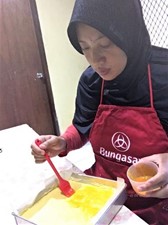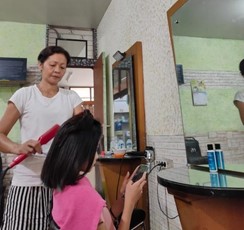By Caroline Mangowal (PhD, Founder of RISE Indonesia)
RISE conducted a small-scale qualitative research project in Greater Jakarta in May 2022 to explore emerging payment systems and financial inclusion (contrasting cash and digital dependency and the entanglement between the two, exploring the pros and cons). We selected 12 women entrepreneurs (between 20 and 50 years old) based on their regular mode of payment: heavy cash users conduct transactions mostly using cash, mixed cash and digital users frequently transition between cash and digital, and heavy digital users conduct transactions mostly using digital payments. The research respondents were owners of various microbusinesses: hairdresser, bakery, food box, merchandise production, fish farming, make-up artist, poultry, catering, clothing, and retail product distributor. They also promoted and sold their products in multiple super-apps and e-commerce platforms.

All respondents, including the heavy cash users, had formal financial accounts and used digital financial services. They had multiple e-money accounts to facilitate their businesses and personal transactions, used ATM/CDM and mobile banking to transfer cash between accounts, and rarely went to a physical bank branch, except for a few who regularly visited to print their transactions in their savings books.
The use of digital services as a mode of payment was popular among all respondents. Quick Response Indonesia Standard (QRIS) digital payment was preferred over other methods because it is linked directly with a business owner’s bank account, which makes it easy to use for withdrawals. By contrast, e-money is a non-bank product, and the owner needs to order a transfer to a bank account prior to withdrawal. Credit cards were not used often by respondents, either for receiving or paying.
One of the things that stands in the way of more people using digital payments is a lack of interoperability, both for e-money and bank accounts (which charge fees for transfers). To get around extra expenses, which can be substantial, entrepreneurs open a number of accounts from different financial institutions and use specific payment options for specific customers or to pay their suppliers. But this practice leads to additional administrative costs and requires the entrepreneurs to keep a minimum balance to maintain the account. The Basic Savings Account (BSA) products in various banks, which do not charge administrative fees, are not widely known or used by entrepreneurs.
To get around transfer fees, entrepreneurs have turned to popular applications, such as ShopeePay, DANA, and FLIP (the most popular), that allow transfers between providers without any charge, with a limited number of transactions per day.
 Heavy cash users actually prefer using digital payments because they are seen as providing
more privacy, security, and convenience. However, they were forced to use cash because
that is what their customers preferred. For example, Dewi, a heavy cash user, has
been distributing poultry eggs in a prime residential area since 2020, with an average
business volume of about IDR 500 million (USD 34,500) per week. Around 75% of her
sales are received in cash, as preferred by household customers.
Heavy cash users actually prefer using digital payments because they are seen as providing
more privacy, security, and convenience. However, they were forced to use cash because
that is what their customers preferred. For example, Dewi, a heavy cash user, has
been distributing poultry eggs in a prime residential area since 2020, with an average
business volume of about IDR 500 million (USD 34,500) per week. Around 75% of her
sales are received in cash, as preferred by household customers.
Every other day, around 9 p.m., she deposits cash from her sales to the Cash Deposit
Machine at her bank. She has to deposit through three or four machines because each
one has a deposit limit, and it takes 20 to 40 minutes to complete the process. Depositing
small banknotes (below IDR 50,000) is also difficult because not all machines accept
them. She would collect five days’ worth of small banknotes, amounting to IDR 20–35
million (around USD 1,300–2,400), before depositing them. While she mainly receives
cash payments from customers, most payments to suppliers are through bank transfers.
According to Dewi, “Depositing a large amount of money through CDM at night is extremely
risky, but I have no other choices. It is more comfortable to use digital payment.
But I cannot force it to my agents or customers. They’ll easily leave me.”
 Another challenge is lack of bank interoperability. Dewi sometimes has difficulty
transferring large amounts of money to her suppliers because a supplier’s account
is different from the main account she uses, and the transfer limit is smaller for
interbank transactions. When she needs to transfer beyond the limit, she then uses
her husband’s account. When asked why she didn’t increase her transaction limit, she
said it was because of the long queues and unfriendly staff at the bank.
Another challenge is lack of bank interoperability. Dewi sometimes has difficulty
transferring large amounts of money to her suppliers because a supplier’s account
is different from the main account she uses, and the transfer limit is smaller for
interbank transactions. When she needs to transfer beyond the limit, she then uses
her husband’s account. When asked why she didn’t increase her transaction limit, she
said it was because of the long queues and unfriendly staff at the bank.
Finally, technological obstacles hindered digital payment systems. Even though Jakarta is a metropolitan capital, respondents still reported internet problems, which may be infrequent but can still cause annoying disruptions. Respondents maintain several telco providers as a backup. Heavy digital users also experienced system failures when they were making transactions, and they maintain several financial service providers as a backup. Respondents also desired a lighter app, which would require less internet bandwidth and RAM, and wished for more expansive use of digital financial services among partners (buyers and sellers) so that they could be fully digitized in conducting their financial transactions.
Conclusions
Driven by security, comfort, and the ease of accessing services, business actors in
greater Jakarta are aware of the importance of using digital financial services, and
they have used these services regularly. However, most still make cash transactions
because their wider business ecosystem still depends on the use of cash. Although
infrastructure is not a significant obstacle in metropolitan areas like Jakarta, the
lack of interoperability between providers, which increases the cost per use, is still
a significant obstacle.
On the supply side, stakeholders need to encourage interoperability among digital
financial services through an enabling regulatory environment and provision of incentives.
On the demand side, a program that uses digital payments in various public services,
such as in the delivery of nationwide government assistance or subsidies, could further
promote the wider adoption of digital financial services.
Figure 1. Jartin Eka, bakery owner and heavy digital payment user. (Courtesy of Jartin
Eka)
Figure 2. Dewi, poultry seller and heavy cash user. (Courtesy of Dewi)
Figure 3. Eka Listyani, salon owner and heavy digital payment user. (Courtesy of Eka
Listyani)
This work was conducted as an independent 2022 research project on central bank digital currency and financial inclusion, in collaboration with Maiden Labs, the MIT Digital Currency Initiative, and the Institute for Money, Technology & Financial Inclusion, and funded by the Gates Foundation. You may view the context of this study on the IMTFI blog and details of the new research report release here.
Original blogpost published on the IMTFI Blog on February 23, 2023 can be found here:
CBDC Field Research Insights: Digital versus Cash Use among Women Urban Entrepreneurs
in Greater Jakarta



